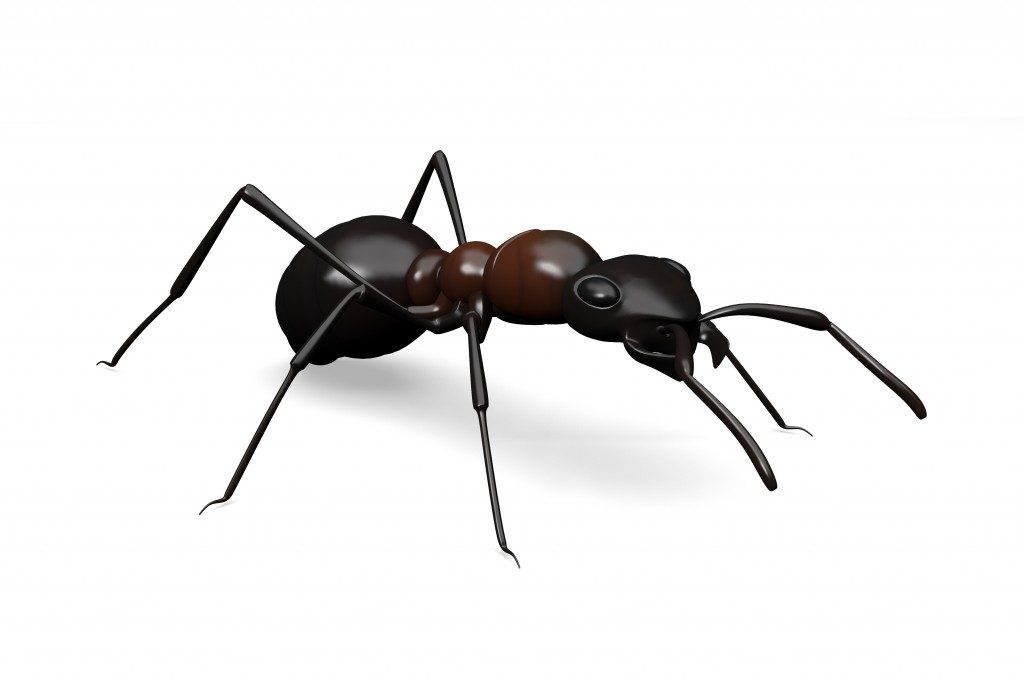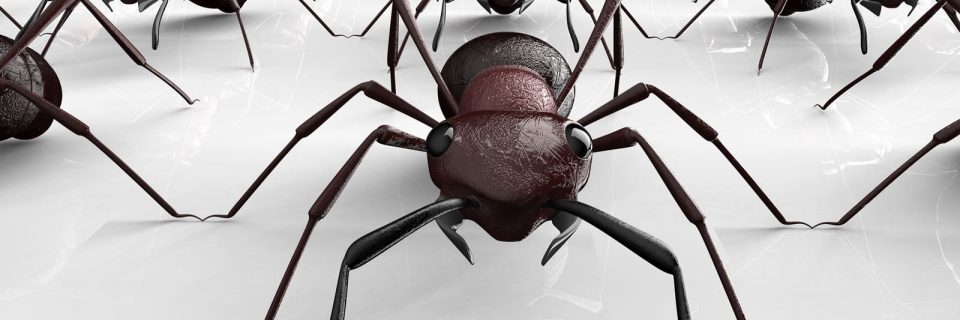Oakmont Ant Control: How to Get Rid of Ants NJ?
How do you Get Rid of Ants NJ? Ant Control at Oakmont Environmental is handled differently: we understand that Ants come from the outdoors whether they are Acrobat, Carpenter, Pharaoh, Citronella, Harvester, Field, Odorous House, Pavement, Thief or Little Black Ants.
Ants are not indigenous to your indoors or outdoor recreation areas and therefore should be there. The Oakmont first step in our Ant control program is to Restore the Natural Order, making insects want to stay outdoors in the soil where they belong. This is all part of the Green IPM (Integrated Pest Management) approach that we follow at Oakmont Environmental to get rid of ants NJ, which mandates that we perform the following:
- Monitoring
- Educating
- Communicating
- Integrating Controls
- Thresholds
- Evaluation
Adhering to these strict Green IPM principles is only one way Oakmont serves both Residential and Business customers better. We also try to use as few pesticides as possible. Instead, we use a hybrid blend of organic, synthetic and nutritional products working in harmony with your surroundings to control invasive insect species and get rid of ants.
The Oakmont IPM Ant Control program calls for the use of more ABS (Active Baiting Station) technologies instead of just spraying pesticides that can wash down and into our watersheds. With ABS we place baits around your home or business that Ants find delicious to lure away from the places they should not be, like inside your house, landscapes and beds.
With ABS, when the insects feed on the bait they will deliver a lethal meal back to their colonies and nests for complete elimination. This is how to get rid of ants NJ efficiently.
Advantages of Ant Active Baiting Stations include:
- Faster bait delivery- bait available to insect from Day One.
- Highly durable bait matrix is available 24/7/365 to insects
- Provide a formidable proactive line of defense for your home or business
- One bait station has enough active ingredient to eliminate an entire colony

We Get Rid of Ants at Oakmont Environmental; Here are Some of the Ants we Target:
Acrobat Ants – get their common name from raising its abdomen over its thorax and head when disturbed. These ants, which are actually several species, will bite on occasion and will give off a repulsive odor when disturbed.
Outdoors, acrobat ants can feed on honeydew from aphids, mealybugs, and live or dead insects. They are typically found under rocks, or in logs, firewood, and trees. These ants prefer nesting in moist wood softened by decay or fungi. Occasionally, acrobat ants will strip the insulation from electrical or telephone wires causing short circuits.
Inside a structure, acrobat ants can feed on sweets and high-protein foods (meats). They may nest in wall voids, baseboards, or door and window framing particularly if it has been damaged by moisture or previously infested with other insects. They may even enlarge cavities formed by other insects such as old galleries of termites, carpenter ants, and other wood-infesting insects. Rigid board insulation used to construct walls of many newer homes also is an attractive nesting site for acrobat ants.
For more detailed information click here!
Carpenter Ant – Many kinds of ants can become pests in and around a home or structure. One of the most common is the carpenter ant. Carpenter ants belong to the largest of all ant groups. Although carpenter ants are usually more of a problem in the Northwest and Northeast, they can be both a nuisance and a serious structural pest across the southeastern United States.
Carpenter ants play an important role in the forest ecosystem. They are responsible for excavating and breaking down wood. It is this behavior that gives them their common name. They do not eat wood like termites, but tunnel into wood to make a nest. One sign that carpenter ants are present is a pile of wood shavings outside a hole or opening. The wood shavings will be coarse and there will be insect parts mixed among them. The ants form a network of galleries in the wood, often across the grain, where they live. The colony is protected, inside in the wood.
For more detailed information click here!
Pharaoh Ant – The name possibly arises from the mistaken idea that it was one of the plagues of ancient Egypt. This common household ant is distributed worldwide and carries the dubious distinction of being the most difficult household ant to control.
Pharaoh Ants have been carried by commerce to all inhabited regions of the earth. This ant, which is probably a native of Africa, does not nest outdoors except in southern latitudes and has been able to adapt to field conditions in southern Florida. In colder climates, it has become established in heated buildings.
For more detailed information click here!
Citronella Ant – The citronella ants get their name from the lemon verbena or citronella odor they emit when threatened. It is most noticeable when the ants are crushed. They are subterranean insects that feed on the honeydew (excretions) of aphids and mealybugs feeding on the roots of shrubs.
Both the larger and the smaller yellow ant are found throughout much of the continental United States. They are very common in the eastern United States and are frequently confused with termites when they swarm into the living areas of homes. In both species, the swarmers (winged ants) may vary in color from the more common light yellow to a dark reddish-yellow or light brown. The workers are typically yellow with less color variation than the swarmers.
For more detailed information click here!
Harvester Ant – Harvester ants is a common name for any of the species or genera of ants that collect seeds (called seed predation), or mushrooms as in the case of Euprenolepis procera, which are stored in the nest in communal chambers called granaries. Seed harvesting by some desert ants is an adaptation to the lack of typical ant resources such as prey or honeydew from hemipterans. Harvester ants increase seed dispersal, protection, and provide nutrients that increase seedling survivorship of the desert plants. In addition, ants provide soil aeration through the creation of galleries and chambers, mix deep and upper layers of soil, and incorporate organic refuse into the soil.
For more detailed information click here!
Little Black Ant – The little black ant is a species of ant native to North America. It is a shiny black color, the workers about 1 to 2 mm long and the queens 4 to 5 mm long. It is a monomorphic species, with only one caste of worker, and polygyne, meaning a nest may have more than one queen. A colony is usually moderately sized with only a few thousand workers.
Little Black Ants are scavengers that will consume anything from bird droppings to dead insects. Workers may forage in households, but nest in soil mounds. It also tends aphids such as the soybean aphid, harvesting honeydew.
During mid-summer the queens and males perform the nuptial flight, mating in midair. The males die shortly after. Each queen constructs a new nest, sheds its wings, and lays eggs. The development from egg to adult takes about a month.
In a laboratory setting queens were found to live about one year and workers about four months
For more detailed information click here!
Field Ant – Typically, they are found in yards and fields, and are known by many names such as thatching, red or wood ants. The names reflect either the materials they use for their nests or their color. While they are usually considered beneficial, at times larger populations may become a nuisance.
Field ants are the largest group of ants, and as such, they are very diverse. Therefore, few generalizations can be made. They are found around structures, but do not often invade homes. They nest in soil, constructing mounds that usually do not exceed the height of the grass.
Nests also may be found under lawn and wood debris such as firewood piles, bricks, lawn ornaments, and other protected places. These types of locations should be inspected carefully for colonies when conducting control efforts. The primary food source of many field ants is honey-dew from plant-sucking insects such as aphids, mealy-bugs, and plant scales (Fig.3). However, some species are scavengers and predators.
For more detailed information click here!
Odorous House Ant – The odorous house ant is native to most of the entire United States ranging from Canada into Mexico. These ants feed on many different items including most items found in homes but apparently prefer to feed on those high in sugars. Outside, Tapinoma sessile will feed on honeydew excreted by aphids and on nectar from flowers and buds.
Odorous house ants can develop extremely large colonies but tend to maintain colonies of only several thousand workers with many queens. Winged reproductives appear in May through July. Workers are very active and move rapidly in single files. They mostly prefer sweets but will also feed on dead insects and grease. Nests are typically found outside under rocks, boards and the like, but can also next within structures. Colonies are from hundreds to many thousands of individuals in size.
Odorous house ants will nest indoors near sources of moisture and warmth, in voids, but also in termite-damaged wood. Their ability to feed on many types of food brings them into conflict with us when they contaminate stored products in the pantry.
For more detailed information click here!
Pavement Ant – The pavement ant is an introduced species and is one of the most commonly encountered house-infesting ants in Pennsylvania. The ants were likely carried to the United States in the holds of merchant vessels during the 1700’s to 1800’s. These ships were filled with soil from Europe to provide ballast on the trip to the States. Once in port, the soil was removed, and goods were loaded on the ships to carry back across the Atlantic.
The pavement ant is a soil-nesting species that currently has a distribution from New England to the Midwest, and south through the Mid-Atlantic States to Tennessee.
Most colonies are located under sidewalks, building slabs, and large rocks. Ants enter buildings through cracks in foundation walls and interior slabs. It is common to see sand piles and small soil particles in structures near cracks in concrete slabs or at the top of foundation walls where the ants deposit debris from excavated nests. Similar piles are seen in the warmer months at the cracks in sidewalks.
Pavement ants feed on a wide variety of food. Sweets, including sugar, nectar, fruits, and syrups are readily taken. Grease, dead insects, and small seeds also are collected and stored in the nest. Nearly any morsel of food that falls to the floor will be consumed.
For more detailed information click here!
Thief Ant – Thief ants are a native species that is found throughout much of the eastern 2/3 of the United States. These ants are so small that they frequently go unnoticed in the home and would certainly enjoy feeding on potato chips and other ‘greasy’ items in the kitchen. They get their common name from the habit of nesting close to other ant species and raiding those nests of eggs, larvae and other food items.
Thief Ant colonies may have up to several thousand workers and multiple queens. They tend to nest in or close to the nests of other ants and will steal food and larvae (as food). There is a strong preference for protein, as thief ants will feed on animal carcasses, but they are also attracted to sweets.
Thief ants will enter structures through cracks in the foundation or small openings in woodwork and commonly during hot weather. They forage in trails throughout a structure seeking protein, sweets and liquid. Outdoors they nest under objects and in soil.
For more detailed information click here!



